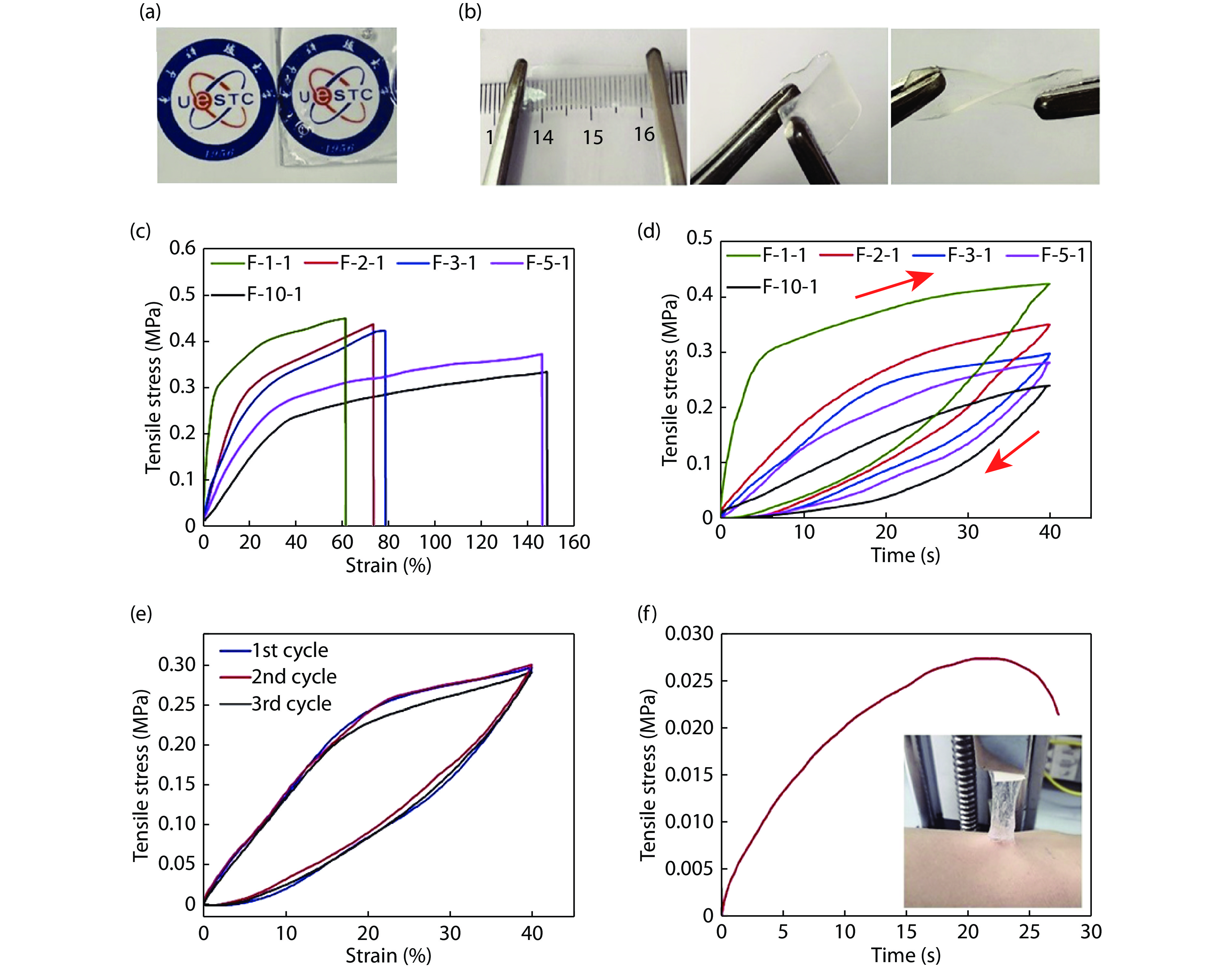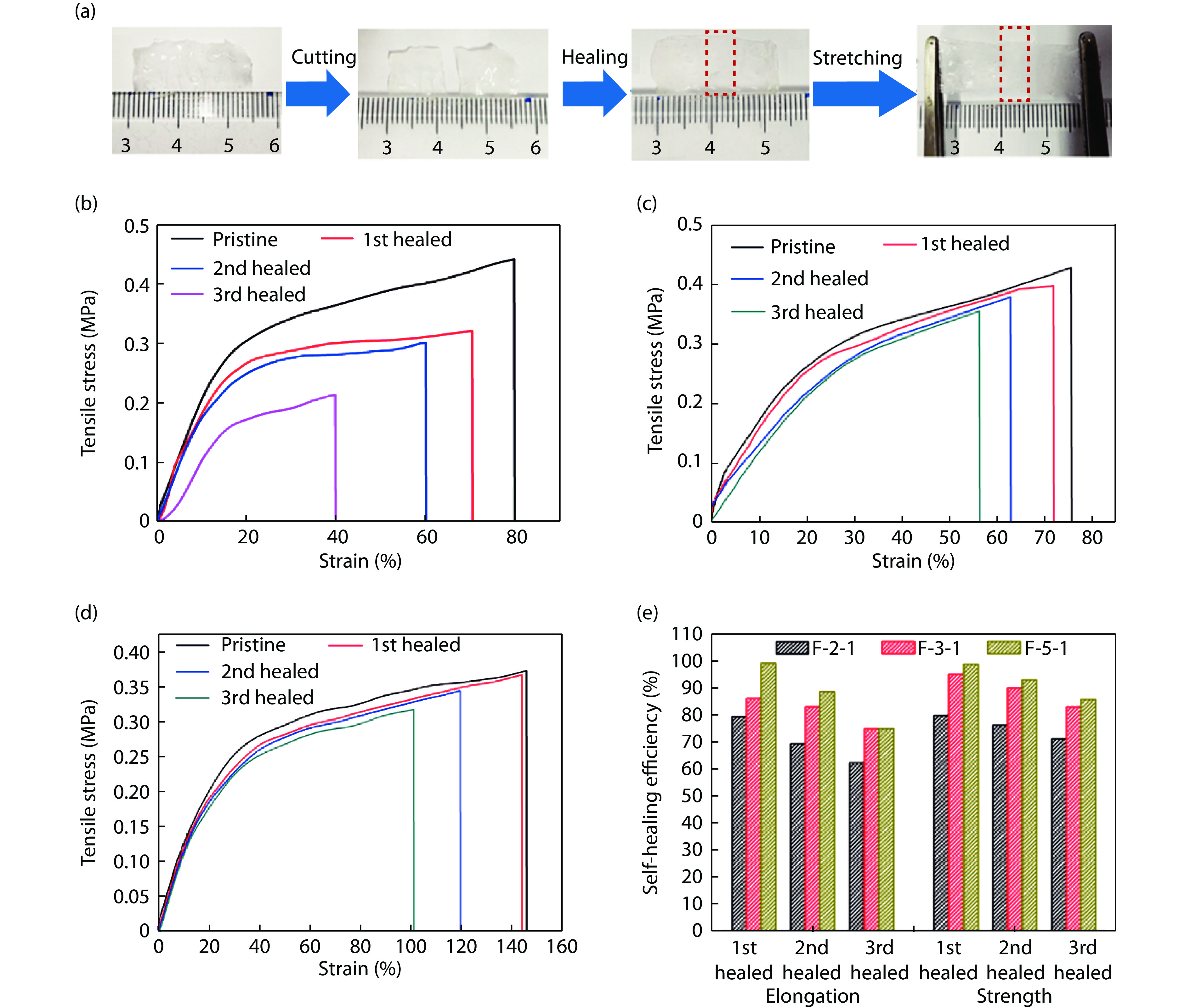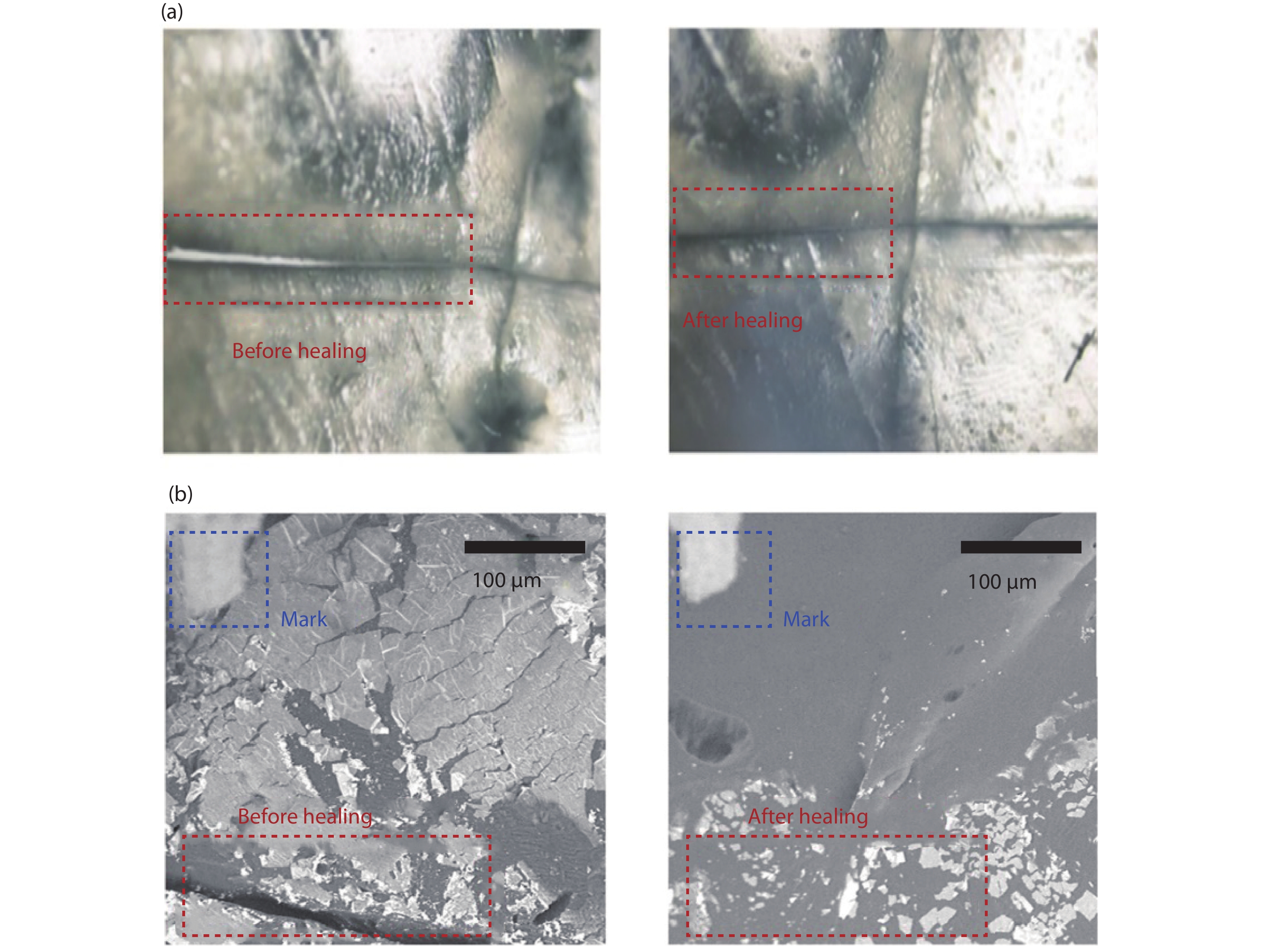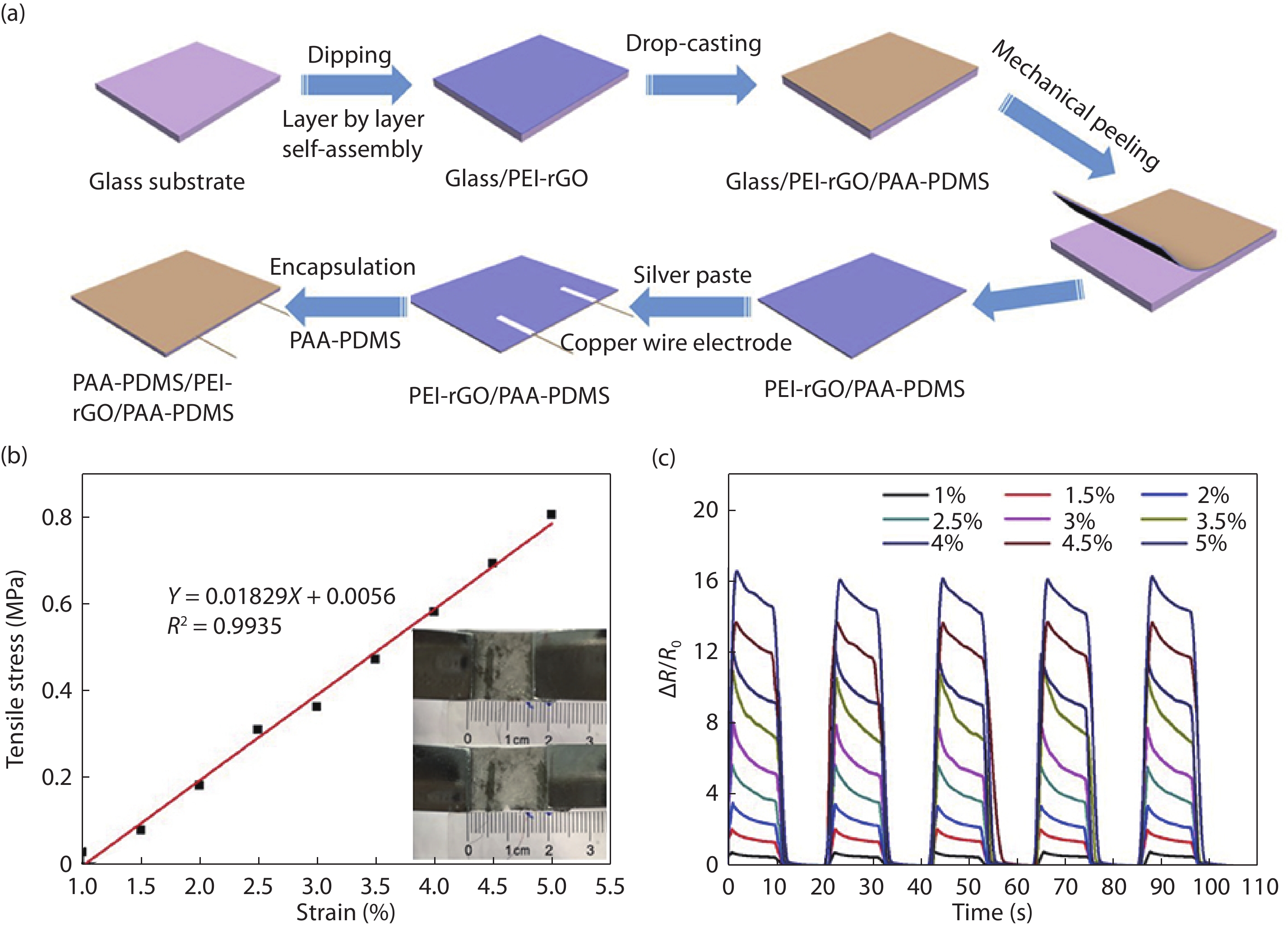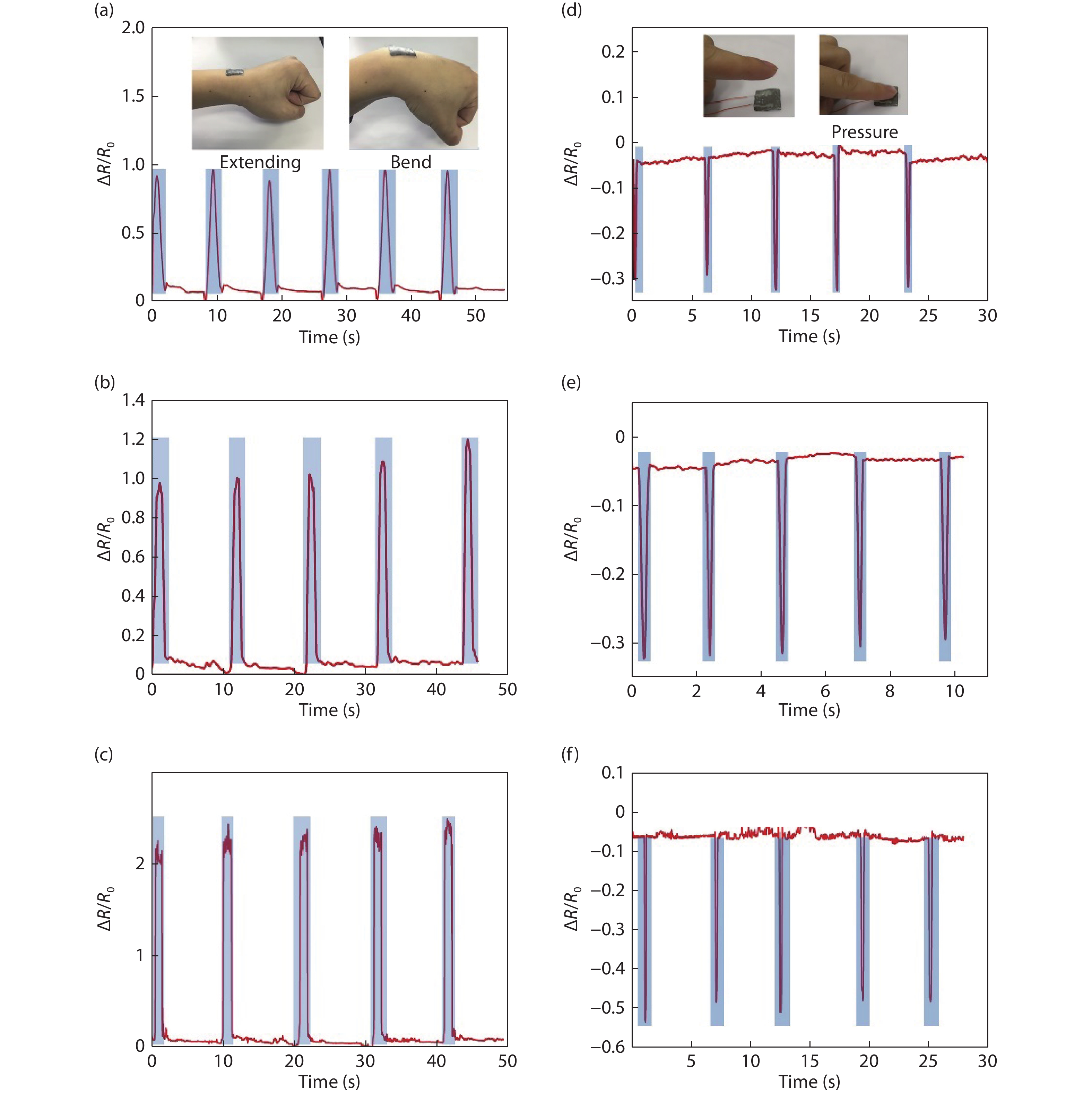| Citation: |
Yujin Yao, Huiling Tai, Dongsheng Wang, Yadong Jiang, Zhen Yuan, Yonghao Zheng. One-pot preparation and applications of self-healing, self-adhesive PAA-PDMS elastomers[J]. Journal of Semiconductors, 2019, 40(11): 112602. doi: 10.1088/1674-4926/40/11/112602
****
Y J Yao, H L Tai, D S Wang, Y D Jiang, Z Yuan, Y H Zheng, One-pot preparation and applications of self-healing, self-adhesive PAA-PDMS elastomers[J]. J. Semicond., 2019, 40(11): 112602. doi: 10.1088/1674-4926/40/11/112602.
|
One-pot preparation and applications of self-healing, self-adhesive PAA-PDMS elastomers
DOI: 10.1088/1674-4926/40/11/112602
More Information
-
Abstract
A new family of transparent, biocompatible, self-adhesive, and self-healing elastomer has been developed by a convenient and efficient one-pot reaction between poly(acrylic acid) (PAA) and hydroxyl-terminated polydimethylsiloxane (PDMS-OH). The condensation reaction between PAA and PDMS-OH has been confirmed by attenuated total reflection Fourier transform infrared (ATR-FTIR) spectra. The prepared PAA-PDMS elastomers possess robust mechanical strength and strong adhesiveness to human skin, and they have fast self-healing ability at room temperature (in ~10 s with the efficiency of 98%). Specifically, strain sensors were fabricated by assembling PAA-PDMS as packaging layers and polyetherimide-reduced graphene oxide (PEI-rGO) as strain-sensing layers. The PAA-PDMS/PEI-rGO sensors are stably and reliably responsive to slight physical deformations, and they can be attached onto skin directly to monitor the body’s motions. Meanwhile, strain sensors can self-heal quickly and completely, and they can be reused for the motion detecting after shallowly scratching the surface. This work provides new opportunities to manufacture high performance self-adhesive and self-healing materials.-
Keywords:
- self-healing,
- PDMS elastomer,
- self-adhesiveness,
- condensation reaction
-
References
[1] Hager M D, P Greil P, C Leyens C, et al. Self-healing materials. Adv Mater, 2010, 22, 5424 doi: 10.1002/adma.201003036[2] Wool R P. Self-healing materials: a review. Soft Matter, 2008, 4(3), 400 doi: 10.1039/b711716g[3] White S R, N Sottos N, P Geubelle P, et al. Autonomic healing of polymer composites. Nature, 2001, 409(6822), 794 doi: 10.1038/35057232[4] Cho S H, White S R, Braun P V. Self-healing polymer coatings. Adv Mater, 2009, 21(6), 645 doi: 10.1002/adma.200802008[5] Zwaag S. Self-healing materials: An alternative approach to 20 centuries of materials science. The Netherlands: Springer Science Business Media BV, 2008, 30[6] Han Y, Wu X, Zhang X, et al. Self-healing, highly sensitive electronic sensors enabled by metal–ligand coordination and hierarchical structure design. ACS Appl Mater Interfaces, 2017, 9(23), 20106 doi: 10.1021/acsami.7b05204[7] Yamada T, Hayamizu Y, Yamamoto Y, et al. A stretchable carbon nanotube strain sensor for human-motion detection. Nanotech, 2011, 6(5), 296 doi: 10.1038/nnano.2011.36[8] Yang Y, Zhu B, Yin D, et al. Flexible self-healing nanocomposites for recoverable motion sensor. Nano Energy, 2015, 17, 1 doi: 10.1016/j.nanoen.2015.07.023[9] Hu Y, Zhao T, Zhu P, et al. A low-cost, printable, and stretchable strain sensor based on highly conductive elastic composites with tunable sensitivity for human motion monitoring. Nano Res, 2018, 11(4), 1938 doi: 10.1007/s12274-017-1811-0[10] Liao M, Wan P, Wen J, et al. Wearable, healable, and adhesive epidermal sensors assembled from mussel-inspired conductive hybrid hydrogel framework. Adv Funct Mater, 2017, 27(48), 1703852 doi: 10.1002/adfm.201703852[11] Chen P, Li Q, Grindy S, et al. White-light-emitting lanthanide metallogels with tunable luminescence and reversible stimuli-responsive properties. Chem Soc, 2015, 137(36), 11590 doi: 10.1021/jacs.5b07394[12] Wang C, Wu H, Chen Z, et al. Self-healing chemistry enables the stable operation of silicon microparticle anodes for high-energy lithium-ion batteries. Nat Chem, 2013, 5(12), 1042 doi: 10.1038/nchem.1802[13] Jin H, Huynh T P, Haick H. Self-healable sensors based nanoparticles for detecting physiological markers via skin and breath: toward disease prevention via wearable devices. Nano Lett, 2016, 16(7), 4194 doi: 10.1021/acs.nanolett.6b01066[14] Pantelopoulos A, Bourbakis N G. A survey on wearable sensor-based systems for health monitoring and prognosis. IEEE Trans Syst Man Cy C, 2010, 40(1), 1 doi: 10.1109/TSMCC.2009.2032660[15] Wang D Y, Tao L Q, Y Liu Y, et al. High performance flexible strain sensor based on self-locked overlapping graphene sheets. Nanoscale, 2016, 8(48), 20090 doi: 10.1039/C6NR07620C[16] Pang C, Lee C, Suh K Y. Recent advances in flexible sensors for wearable and implantable devices. J Appl Polym Sci, 2013, 130(3), 1429 doi: 10.1002/app.39461[17] Choi S, Lee H, Ghaffari R, et al. Recent advances in flexible and stretchable bio-electronic devices integrated with nanomaterials. Adv Mater, 2016, 28(22), 4203 doi: 10.1002/adma.201504150[18] Chen D, Wang D, Yang Y, et al. Self-healing materials for next-generation energy harvesting and storage devices. Adv Energy Mater, 2017, 7(23), 1700890 doi: 10.1002/aenm.201700890[19] Gao N, Fang X. Synthesis and development of graphene–inorganic semiconductor nanocomposites. Chem Rev, 2015, 115(16), 8294 doi: 10.1021/cr400607y[20] Ning Y, Zhang Z, Teng F, et al. Novel transparent and self-powered UV photodetector based on crossed ZnO nanofiber array homojunction. Small, 2018, 14(13), 1703754 doi: 10.1002/smll.201703754[21] Darabi M A, A Khosrozadeh A, R Mbeleck R, et al. Skin-inspired multifunctional autonomic-intrinsic conductive self-healing hydrogels with pressure sensitivity, stretchability, and 3D printability. Adv Mater, 2017, 29(31), 1700533 doi: 10.1002/adma.201700533[22] Li J, Geng L, Wang G, et al. Self-healable gels for use in wearable devices. Chem Mater, 2017, 29(21), 8932 doi: 10.1021/acs.chemmater.7b02895[23] Cai G, Wang J, Qian K, et al. Extremely stretchable strain sensors based on conductive self-healing dynamic cross-links hydrogels for human-motion detection. Adv Sci, 2017, 4(2), 1600190 doi: 10.1002/advs.201600190[24] Liu Y J, Cao W T, Ma M G, et al. Ultrasensitive wearable soft strain sensors of conductive, self-healing, and elastic hydrogels with synergistic " soft and hard” hybrid networks. ACS Appl Mater Interfaces, 2017, 9(30), 25559 doi: 10.1021/acsami.7b07639[25] Liu S, Zheng R, Chen S, et al. A compliant, self-adhesive and self-healing wearable hydrogel as epidermal strain sensor. J Mater Chem C, 2018, 6(15), 4183 doi: 10.1039/C8TC00157J[26] Liu X, Lu C, Wu X, et al. Self-healing strain sensors based on nanostructured supramolecular conductive elastomers. J Mater Chem A, 2017, 5(20), 9824 doi: 10.1039/C7TA02416A[27] Keller M W, White S R, Sottos N R. A self-healing poly (dimethyl siloxane) elastomer. Adv Funct Mater, 2007, 17(14), 2399 doi: 10.1002/adfm.200700086[28] Zhang D D, Ruan Y B, Zhang B Q, et al. A self-healing PDMS elastomer based on acylhydrazone groups and the role of hydrogen bonds. Polymer, 2017, 120, 189 doi: 10.1016/j.polymer.2017.05.060[29] Zhang A, Yang L, Lin Y, et al. Self-healing supramolecular elastomers based on the multi-hydrogen bonding of low-molecular polydimethylsiloxanes: Synthesis and characterization. J Appl Polym Sci, 2013, 129(5), 2435 doi: 10.1002/app.38832[30] Zhao J, Xu R, Luo G, et al. A self-healing, re-moldable and biocompatible crosslinked polysiloxane elastomer. J Mater Chem B, 2016, 4(5), 982 doi: 10.1039/C5TB02036K[31] Zhang B, Zhang P, Zhang H, et al. A transparent, highly stretchable, autonomous self-healing poly(dimethyl siloxane) elastomer. Macromol Rapid Commun, 2017, 38(15), 1700110 doi: 10.1002/marc.201700110[32] Mei J F, Jia X Y, Lai J C, et al. A highly stretchable and autonomous self-healing polymer based on combination of pt·pt and π–π interactions. Macromol Rapid Comm, 2016, 37(20), 1667 doi: 10.1002/marc.201600428[33] Jia X Y, Mei J F, Lai J C, et al. A self-healing PDMS polymer with solvatochromic properties. Chem Commun, 2015, 51(43), 8928 doi: 10.1039/C5CC01956G[34] Jia X Y, Mei J F, Lai J C, et al. A highly stretchable polymer that can be thermally healed at mild temperature. Macromol Rapid Commun, 2016, 37(12), 952 doi: 10.1002/marc.201600142[35] Rao Y L, Chortos A, Pfattner R, et al. Stretchable self-healing polymeric dielectrics cross-linked through metal–ligand coordination. J Am Chem Soc, 2016, 138(18), 6020 doi: 10.1021/jacs.6b02428[36] Cao J, Zhang X, Lu C, et al. Self-healing sensorsbased ondual noncovalent network elastomer for human motion monitoring. Macromol Rapid Commun, 2017, 38(23), 1700406 doi: 10.1002/marc.201700406[37] Ye X, Yuan Z, Tai H, et al. A wearable and highly sensitive strain sensor based on a polyethylenimine–rGO layered nanocomposite thin film. J Mater Chem C, 2017, 5(31), 7746 doi: 10.1039/C7TC01872J[38] Shobhana E. X-Ray diffraction and UV-visible studies of PMMA thin films. Int J Modern Eng Res, 2012, 2(3), 1092[39] Wang T, Isimjan T T, Chen J, et al. Transparent nanostructured coatings with UV-shielding and superhydrophobicity properties. Nanotechnology, 2011, 22(26), 265708 doi: 10.1088/0957-4484/22/26/265708[40] De Giglio E, Cometa S, Cioffi N, et al. Analytical investigations of poly (acrylic acid) coatings electrodeposited on titanium-based implants: a versatile approach to biocompatibility enhancement. Anal Bioanal Chem, 2007, 389(7/8), 2055 doi: 10.1007/s00216-007-1299-7[41] Yu H, Fu G, He B. Preparation and adsorption properties of PAA-grafted cellulose adsorbent for low-density lipoprotein from human plasma. Cellulose, 2006, 14(2), 99 doi: 10.1007/s10570-006-9080-1[42] Dai J, Bao Z, Sun L, et al. High-capacity binding of proteins by poly (acrylic acid) brushes and their derivatives. Langmuir, 2006, 22(9), 4274 doi: 10.1021/la0600550[43] Drotlef D M, Amjadi M, Yunusa M, et al. Bioinspired composite microfibers for skin adhesion and signal amplification of wearable sensors. Adv Mater, 2017, 29(28), 1701353 doi: 10.1002/adma.201701353[44] Liu Y, Pharr M, Salvatoreg G A. Lab-on-skin: a review of flexible and stretchable electronics for wearable health monitoring. ACS Nano, 2017, 11(10), 9614 doi: 10.1021/acsnano.7b04898[45] Song Y K, Jo Y H, Lim Y J, et al. Sunlight-induced self-healing of a microcapsule-type protective coating. ACS Appl Mater Interfaces, 2013, 5(4), 1378 doi: 10.1021/am302728m[46] Mangun C L, Mader A C, Sottos N R, et al. Self-healing of a high temperature cured epoxy using poly (dimethylsiloxane) chemistry. Polymer, 2010, 51(18), 4063 doi: 10.1016/j.polymer.2010.06.050 -
Proportional views





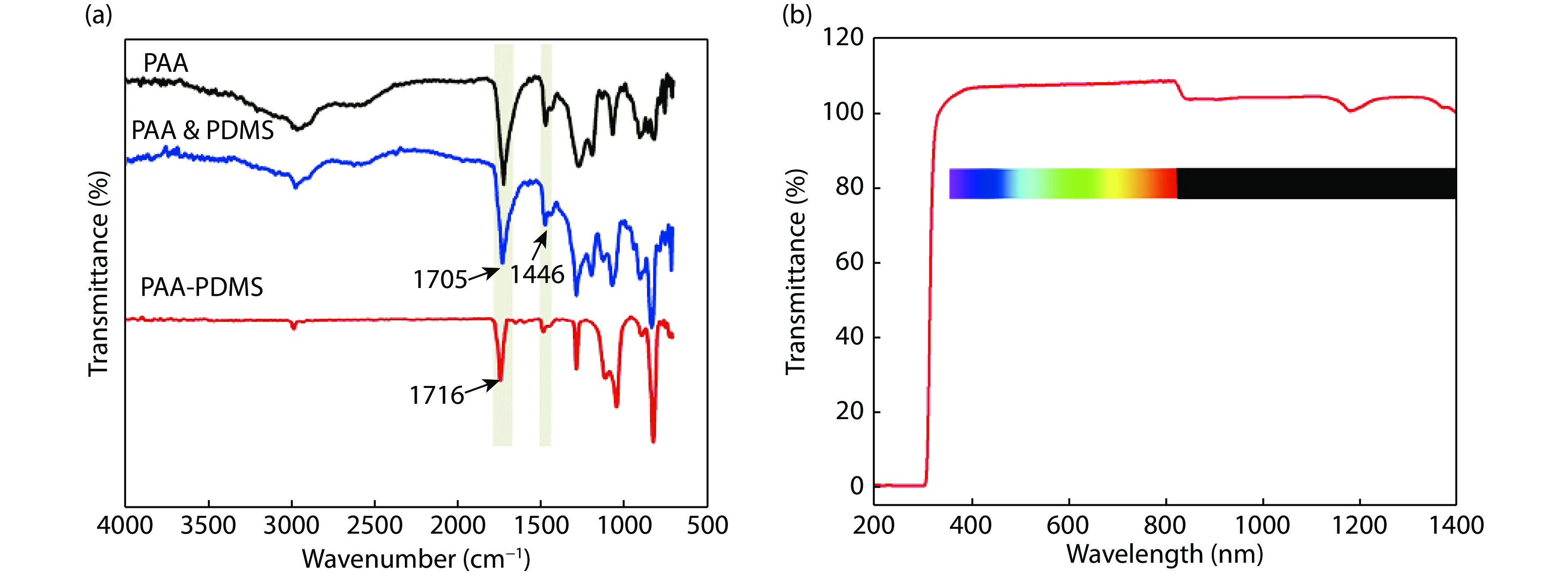
 DownLoad:
DownLoad:
